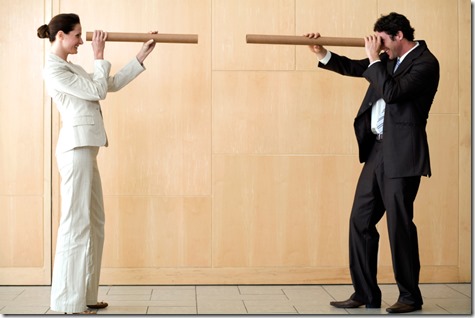Should I Continue Maintaing Eye Contact After 3 Seconds
For How Many Seconds Should You Make Eye Contact?
If you read a few public speaking books, you'll probably come across conflicting advice about how long you should maintain eye contact with an audience member before moving on to someone else.
Here are a few examples from writers whose insight I respect:
In You Are The Message, Roger Ailes writes: "As you move from small group to small group—or from individual to individual—in the audience, linger for a few seconds."
On his website "Six Minutes," public speaking blogger Andrew Dlugan recommends that speakers "Sustain eye contact with someone for a few seconds, then move on."
In 100 Things Every Presenter Needs To Know About People, Susan Weinschenk gets slightly more specific: "Spend 2 to 3 seconds looking at one person, then move to another person."
In Presentation Skills 201, William R. Steele agrees: "Look at someone just long enough that you both feel the connection (two or three seconds) and then move on.

Presentations That Persuade and Motivate, published by the Harvard Business Press, recommends doubling that time: "Make eye contact for five or six seconds with people in the front, left and right, and the back."
In Speak With Confidence, Dianna Booher dispenses with that approach, advising speakers to focus not on seconds, but on sentences: "Delivering one or two sentences to each person establishes a bond of intimacy with individual listeners."
Jerry Weissman's The Power Presenter has similar advice, but recommends less time-per-person: "Deliver one phrase to that person. Pause. Move to another person and deliver one phrase to that person."
Who's Right?
All of the writers above offered similar advice, but with meaningful variations. A few of them noted that although a specific number of seconds (or words) could serve as a helpful general guideline, the specific amount of time was less important than what happens during the eye contact—a genuine connection between speaker and audience member. I agree with that.
In my experience, giving speakers a specific timeline to follow gets them too far inside their heads. Instead of focusing on being truly in the moment during their presentations, they suddenly find themselves doing mental math: "One second—two-seconds—three seconds—okay, I need to look at a new person now."
The most useful guideline I can offer is this: You shouldn't say a word unless you're looking someone in the eye and making a connection with that person. (If there's any "rule" beyond that, it should be that you don't dart your eyes so quickly from person to person that you fail to make a connection.) That's all you have to remember. Don't talk to the wall, the floor, the ceiling, your notes, your laptop, or the screen projecting your PowerPoint slides. By remembering to speak into someone's eyes, every word, phrase, sentence, and paragraph you utter will help you forge a meaningful connection.
If, after all of that, you're still seeking a numerical formula, remember this excellent piece of advice from Andrew Dlugan: "There's no magic minimum or maximum; you'll just know."
Want more public speaking tips? Click here to instantly join our weekly mailing list.
Public Speaking Skills Training
Since 2004, we have helped speakers prepare for the world's biggest stages, including TED, the World Economic Forum, and a presidential announcement speech. We're committed to your long-term growth, and we'll be with you every step of the way.
Learn MoreMore from the throughline blog
Join the thousands of professionals who receive our email newsletter. Improve your public speaking and media interviewing skills—and enhance your career—by signing up below.
© 2022 Throughline Group, LLC. All Rights Reserved.
Source: https://www.throughlinegroup.com/2014/06/09/for-how-many-seconds-should-you-make-eye-contact/
0 Response to "Should I Continue Maintaing Eye Contact After 3 Seconds"
Postar um comentário